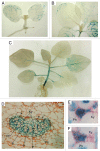Possible role of the Nt-4/1 protein in macromolecular transport in vascular tissue
- PMID: 23887490
- PMCID: PMC4091084
- DOI: 10.4161/psb.25784
Possible role of the Nt-4/1 protein in macromolecular transport in vascular tissue
Abstract
The Arabidopsis thaliana 4/1 (At-4/1) protein has a highly α-helical structure with potential to interact both with itself and other protein ligands, including the movement proteins of some plant viruses; the Nicotiana tabacum ortholog (Nt-4/1) has similar structure. Here we describe localization of GUS expression in transgenic N. tabacum seedlings under control of the Nt-4/1 promoter, which indicates that transcription is associated with the veins at certain developmental stages, and especially in the hypocotyl. Viroid accumulation and movement was altered in plants in which 4/1 expression was reduced by virus-induced gene silencing. These localization studies support a role of 4/1 in signaling in the vasculature,including mobility of pathogen-related and cellular RNAs.
Figures



References
-
- von Bargen S, Salchert K, Paape M, Piechulla B, Kellmann J-W. Interactions between the Tomato spotted wilt virus movement protein and plant proteins showing homologies to myosin, kinesin and DnaJ-like chaperones. Plant Physiol Biochem. 2001;39:1083–93. doi: 10.1016/S0981-9428(01)01331-6. - DOI
-
- Paape M, Solovyev AG, Erokhina TN, Minina EA, Schepetilnikov MV, Lesemann DE, et al. At-4/1, an interactor of the Tomato spotted wilt virus movement protein, belongs to a new family of plant proteins capable of directed intra- and intercellular trafficking. Mol Plant Microbe Interact. 2006;19:874–83. doi: 10.1094/MPMI-19-0874. - DOI - PubMed
-
- Minina EA, Erokhina TN, Garushyants SK, Solovyev AG, Morozov SY. Subcellular localization of the new plant protein 4/1 and analysis of heterologous protein-protein interactions indicate its ability for nuclear-cytoplasmic transport. Dokl Biochem Biophys. 2009;429:296–300. doi: 10.1134/S1607672909060039. - DOI - PubMed
Publication types
MeSH terms
Substances
LinkOut - more resources
Full Text Sources
Other Literature Sources
Research Materials
